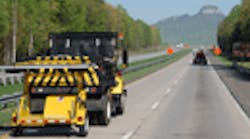Via a series of reports detailing the nation’s transportation woes, the American Association of State Highway and Transportation Officials (AASHTO) is pushing to not only rebuild existing infrastructure, but to significantly expand it to keep up with rapidly increasing demand.
"Our first report, Unlocking Gridlock, shows that we are experiencing system overload,” said John Horsley, AASHTO's executive director, at a news conference in Dallas, yesterday. “While congestion levels declined with the recession, congestion is now returning, costing millions in lost time and productivity. Capacity increases are needed in transit, rail, and particularly in highways.”
Horsley told FleetOwner that while there’s been much ado from the Obama administration and the U.S. Department of Transportation (DOT) of late in terms of beefing up investments in national high speed rail and mass transit systems – efforts AASHTO embraces, he stressed – little is being said about highway expansion.
“DOT has been largely silent on the need for more highway capacity for freight and motorists,” he said. “We need to make clear that highways are an incredibly dominant factor in our economy and society. Trucks move, by value, 93% of the freight in our nation and are projected to handle 95% of it in 30 years, while 95% of the U.S.’s passenger travel occurs via highways.”
"Even with strategies to reduce traffic and improve transit, highway system expansion is critical,” noted AASHTO’s president Larry "Butch" Brown, who is also Director of the Mississippi Dept. of Transportation. "If most or all of our capital investment were made in system rehabilitation and little to none in adding needed capacity, road conditions would improve, but traffic would grind to a halt."
Horsley added that AASHTO’s series of reports – dubbed Transportation Reboot: Restarting America's Most Essential Operating System – examines critical aspects of the nation’s transportation network in terms of reducing congestion, improving the flow of freight, and forging better connections between America’s far-flung urban and rural communities.
The report notes that travel on the U.S. highway system increased five-fold over the past 60 years from 600 billion miles driven to almost three trillion in 2009. It says annual travel is expected to climb to nearly 4.5 trillion miles by 2050 – even with aggressive strategies to cut the rate of growth to only one percent per year.
As a result of higher travel volumes coupled with limited roadway capacity, drivers with a 30-minute commute lose 22 hours annually – nearly three full work days – just sitting in traffic.
“Population increases are putting strains on existing transportation networks, and are increasing the need for new capacity,” Horsley said. “But transit and intercity passenger rail investments alone cannot begin to meet the nation’s transportation needs. And he pointed out that America’s population is forecast to increase from 308 million today to more than 420 million by 2050.
To keep up with such growth requires significantly more highway investment, AASHTO said in its report. For example, the U.S. Department of Transportation’s 2008 Conditions and Performance report – released in early 2010 – projects an annual highway investment need of about $175 billion. Of that amount, $85 billion is needed for system rehabilitation, $71 billion is needed for system expansion and $18 billion is needed for system enhancements such as safety improvements.
“A more balanced approach is needed that recognizes how Americans choose to travel,” Horsley added. “ Today 95% of passenger travel in America is made by car, motorcycle and truck, and 93% of freight by value moves on our highways. Expanding highway capacity is not the only thing that will be required to meet future mobility needs, but it will be a principal part of what will be required.”




